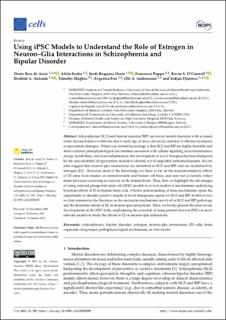Using iPSC Models to Understand the Role of Estrogen in Neuron–Glia Interactions in Schizophrenia and Bipolar Disorder
| dc.contributor.author | de Assis, Denis | |
| dc.contributor.author | Szabo, Attila | |
| dc.contributor.author | Osete, Jordi Requena | |
| dc.contributor.author | Puppo, Francesca | |
| dc.contributor.author | O'Connell, Kevin S. | |
| dc.contributor.author | Akkouh, Ibrahim | |
| dc.contributor.author | Hughes, Timothy | |
| dc.contributor.author | Frei, Evgeniia | |
| dc.contributor.author | Andreassen, Ole Andreas | |
| dc.contributor.author | Djurovic, Srdjan | |
| dc.date.accessioned | 2021-05-20T08:37:28Z | |
| dc.date.available | 2021-05-20T08:37:28Z | |
| dc.date.created | 2021-01-25T21:32:27Z | |
| dc.date.issued | 2021 | |
| dc.Published | Cells. 2021, 10 (2), . | |
| dc.identifier.issn | 2073-4409 | |
| dc.identifier.uri | https://hdl.handle.net/11250/2755796 | |
| dc.description.abstract | Schizophrenia (SCZ) and bipolar disorder (BIP) are severe mental disorders with a considerable disease burden worldwide due to early age of onset, chronicity, and lack of efficient treatments or prevention strategies. Whilst our current knowledge is that SCZ and BIP are highly heritable and share common pathophysiological mechanisms associated with cellular signaling, neurotransmission, energy metabolism, and neuroinflammation, the development of novel therapies has been hampered by the unavailability of appropriate models to identify novel targetable pathomechanisms. Recent data suggest that neuron–glia interactions are disturbed in SCZ and BIP, and are modulated by estrogen (E2). However, most of the knowledge we have so far on the neuromodulatory effects of E2 came from studies on animal models and human cell lines, and may not accurately reflect many processes occurring exclusively in the human brain. Thus, here we highlight the advantages of using induced pluripotent stem cell (iPSC) models to revisit studies of mechanisms underlying beneficial effects of E2 in human brain cells. A better understanding of these mechanisms opens the opportunity to identify putative targets of novel therapeutic agents for SCZ and BIP. In this review, we first summarize the literature on the molecular mechanisms involved in SCZ and BIP pathology and the beneficial effects of E2 on neuron–glia interactions. Then, we briefly present the most recent developments in the iPSC field, emphasizing the potential of using patient-derived iPSCs as more relevant models to study the effects of E2 on neuron–glia interactions. | en_US |
| dc.language.iso | eng | en_US |
| dc.publisher | MDPI | en_US |
| dc.rights | Navngivelse 4.0 Internasjonal | * |
| dc.rights.uri | http://creativecommons.org/licenses/by/4.0/deed.no | * |
| dc.title | Using iPSC Models to Understand the Role of Estrogen in Neuron–Glia Interactions in Schizophrenia and Bipolar Disorder | en_US |
| dc.type | Journal article | en_US |
| dc.type | Peer reviewed | en_US |
| dc.description.version | publishedVersion | en_US |
| dc.rights.holder | Copyright 2021 by the authors. | en_US |
| dc.source.articlenumber | 209 | en_US |
| cristin.ispublished | true | |
| cristin.fulltext | original | |
| cristin.qualitycode | 1 | |
| dc.identifier.doi | 10.3390/cells10020209 | |
| dc.identifier.cristin | 1879144 | |
| dc.source.journal | Cells | en_US |
| dc.source.40 | 10 | |
| dc.source.14 | 2 | |
| dc.identifier.citation | Cells. 2021, 10 (2), 209. | en_US |
| dc.source.volume | 10 | en_US |
| dc.source.issue | 2 | en_US |
Tilhørende fil(er)
Denne innførselen finnes i følgende samling(er)
-
Department of Clinical Science [2295]
-
Registrations from Cristin [9489]

